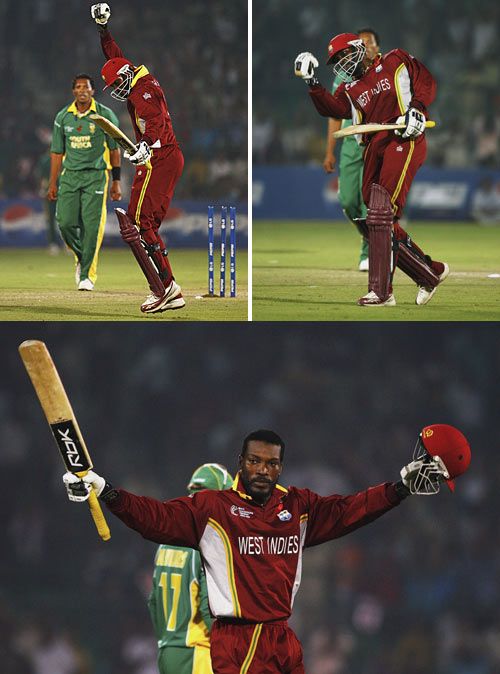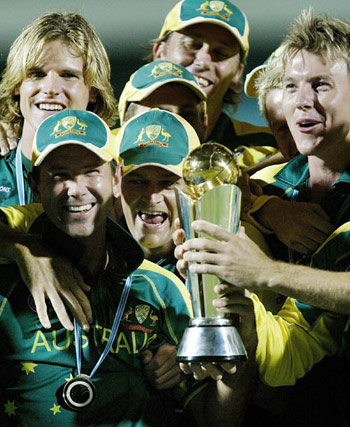A month-long celebration of one-day cricket, the fifth ICC Champions Trophy brings together the 10 Test-playing countries for the only time outside the ICC Cricket World Cup. For the last 30 days, the finest cricketing talent preened and battled around the country, fighting for the second-biggest prize in cricketing world. But still the neither the mood, quality of matches nor excitement just didn't match up.
This ICC Champions Trophy did not produce the cascade of runs that usually come in India. It demanded the batsmen to be more alert to changing conditions, and saw bowlers recall the traditional virtues of swing and accuracy.
Technically-better teams stole a march over the mediocre. In the end, arguably, the best team in the world, Australia, walked away with the trophy.
But the tournament will also be remembered for the West Indies' resurgence and stagnation of India. Defending champions to qualifiers to finalists, the West Indies took its fans on an enjoyable ride while the hosts paid the price for inconsistency with the bat and ball.
This ICC Champions Trophy did not produce the cascade of runs that usually come in India. It demanded the batsmen to be more alert to changing conditions, and saw bowlers recall the traditional virtues of swing and accuracy.
Technically-better teams stole a march over the mediocre. In the end, arguably, the best team in the world, Australia, walked away with the trophy.
But the tournament will also be remembered for the West Indies' resurgence and stagnation of India. Defending champions to qualifiers to finalists, the West Indies took its fans on an enjoyable ride while the hosts paid the price for inconsistency with the bat and ball.
THE GOOD
Aussie rules
Aussie rules
The Champions Trophy and the Australian team mystifyingly had a turbulent relationship till Sunday, November 5. The affair finally became more amiable when skipper Ricky Ponting laid his hands on the second biggest tournament in the world. The monkey is well and truly off the Kangaroo’s back. For the record, the Aussies haven’t lost a final in tournaments featuring more than two teams, since 1999.
The Champions

Chris Gayle made this tournament his own. There are plenty of batsmen in the world capable of scoring 474 runs in a tournament, but few who can do in the crowd-pulling manner that Gayle did. His hitting - against any sort of bowler, on any kind of pitch - was reminiscent somehow of an era when West Indies dominated cricket.

Another star was Jerome Taylor, the leading wicket-taker. Loose limbed and athletic, he ran in with pace and purpose, and really it should have surprised no-one that he did as well as he did, including becoming the first West Indian to pick up a hat-trick. Then there was Damien Martyn, repeatedly coming in to bat after a wobble, steadying the ship with serene batting. There was Stephen Fleming, handing out lessons on how to adjust to different conditions and bat on tricky pitches.
The form book
The early phase of this tournament made it impossible to predict any result with a degree of certainty. Pakistan beat Sri Lanka, West Indies beat Australia, West Indies beat India, New Zealand beat South Africa, South Africa beat Pakistan . The fact that the tournament was played in three different venues, each providing differing pitches, meant that teams had to adapt quickly, and often it was the team that displayed the most tactical nous, and cricketing intelligence, on the day, that won, rather than the better team. This meant that the tournament was wide open for a lot longer than pundits initially expected.
India, the hosts, being knocked out before the semi-final stage, along with Sri Lanka, who appeared to have the early momentum, and Pakistan, left the tournament with no Asian teams going into the last four, and this was a disappointment. But the teams that did make it, South Africa, New Zealand, West Indies, and of course, Australia, were the ones that had played the best cricket at key moments in the tournament.
THE BAD
Wicked Wickets
Wicked Wickets
Since the tournament was played at the beginning of the Indian cricket season, the pitches were still raw. Besides an extended monsoon didn’t help the curators either. The worst affected was the Brabourne Stadium in Mumbai where a string of sub-200 scores resulted in the ICC flying in pitch expert Andy Atkinson, armed with a glue, to ensure the smooth conduct of the final. Oddly enough, the target in the final was an abysmal 138. For a change, the pitch wasn’t blamed.
The noice and the chatter
When the tournament began there was a very real danger that the rumbling spat between the ICC and the Board of Control for Cricket in India (BCCI) would blow-up into a full fledged crisis. With the Indian board either taking shots at the ICC, or replying to remarks made by the ICC, in the media, there was the chance that sports pages would have been filled with Malcolm Speed and Lalit Modi, rather than hard cricket. That this tournament began with a qualifying round - and this inevitably yields one-sided matches, meant that it took some time before the cricket was hot enough to push out the officials from the sports pages. Once things began to fall into place, though, it all changed.
No crowds
The administrators thought the cricket crazy junta in India will lap up any international match that is thrown at them. In their overzealousness, they raised the tickets so high that it went beyond reach of the average fan. Only three matches, all featuring India, did roaring business while the remaining 18 ties, were played before nearly-empty galleries. It is another story though that tickets eventually went for free in most centres once India were knocked out. The long, drawn out schedule too was a deterrent.
THE UGLY
Rope-a-dope
Rope-a-dope
Just when the tournament was warming up, came a body blow from across the border. Two of the potential stars of the event – Shoaib Akhtar and Mohd Asif – had tested positive to high levels of the banned substance nandrolene before they embarked for the event. The revelation not only rocked the event but also wrecked Pakistan’s challenge. It also meant that the tournament was poorer by the absence of two potent pacers.
...and then there was result
The best team in the world qualified to play the final against the team playing the best cricket in the world at the time. You couldn't ask for more, if you were fair. And in the end, as has been the case in many grand finals now - the 1999 World Cup final in England, the 2003 World Cup final in South Africa, and now this - the Australians just blew away the opposition. West Indies had one of their off days, Australia were too strong overall, and go into the Ashes having won the one tournament that eluded them. West Indies had mounted a creditable defence of their title, and played with pride, something that gives you the hope that they can give a good account of themselves when the carnival travels to their part of the world, for the biggest tournament around, not far from now.

4 comments:
gr8 start digit
the whole post was engrossing
and gr8 analysis of the tournament
keep going
ps. where are other guys when they will start posting
i've never had any doubts on your cricketing aptitude...but i never thought u cud vomit it all in such a laconic and organized manner....
sportolysis does well in its initial overs....the opener digit is making the scorers work hard for their money
go go go!
hink you should add an update regarding that awful presentation ceremony where in Ricky Ponting nudged Sharad Pawar, really speaks about the attitude of the folks the world calls champions..
Post a Comment